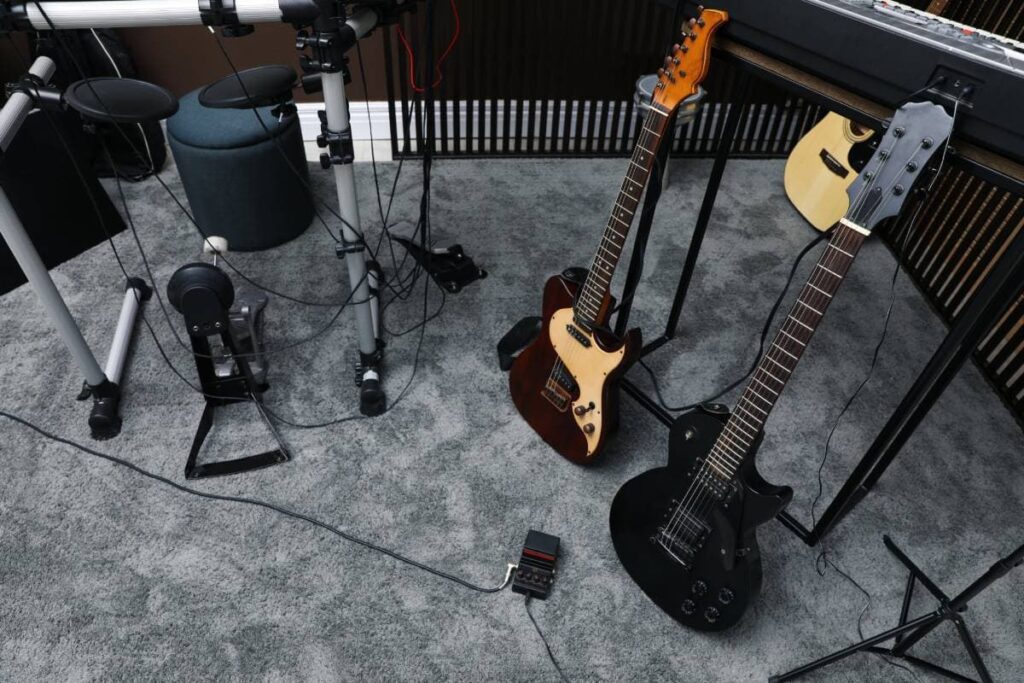Building a home studio is an exciting yet simultaneously daunting experience. There is a ton of conflicting information on the internet about hardware, software, materials you should use, soundproofing, etc.
A thin carpet is suitable for a music studio because it will reduce the natural reverb and echo of the recording room. This will result in a cleaner-sounding recording. A producer or mixer can then add reverb and echo in post-production instead of having the same present in the recording.
In the rest of this article, I’ll explain in-depth why carpet is good for your music studio and how it aids the sound balance. I will also discuss the possible disadvantages of having a carpet in your studio and other flooring materials used in music studios.
Table of Contents
- Why is Carpet Good for Music Studio?
- Disadvantages of Carpet in a Recording Studio
- Other Music Studio Hardwood Flooring Options
- Conclusion

Why is Carpet Good for Music Studio?
While many experts advise against using carpets or rugs in a professional recording studio, it is a viable alternative to acoustic foam as long as it is a thin carpet.
As an acoustic treatment, thick carpets absorb too many high and medium frequencies. Therefore, the carpet’s thickness is imperative when choosing a carpet for your music studio.
A thin music studio carpet can help dampen or muffle undesirable high frequencies and makes a better acoustic treatment. This can happen when a vocalist hits an exceptionally high note, a guitarist plays a very high note on the instrument, a crashing cymbal, or a sharp snare from a drum set.
Hardwood Floors
It also helps to reduce unwanted sound reflections that cause reverb and echo.
This is essential when recording vocals because you want the vocals to be as clean and raw as possible. Excess echo and reverb from hardwood or tile floors can ruin the performances of vocals and several other instruments.
Two of the lesser benefits but benefits nonetheless are that carpets keep instruments like drum sets from sliding around during recordings, and carpets make a room look better.
Carpeted Room
Carpet also dampens the sound of musicians tapping their feet to the beat of the music as a form of their metronome. This would be quite prominent in the recording if the flooring material were tile or hardwood.
All carpets are not created equal, though. A study of the effects of carpets on acoustics found that the thicker the carpet, the more sound it absorbs. This is why thin carpet is a better acoustic treatment for music studios.
It’s enough to remove the echo and reverb of the room but not so much that it dampens the sound of the instruments and vocals.
Another ancillary benefit of carpeting is that it can conceal the many cables and wires that will inevitably cover the bare floor of your music studio or control room. Additionally, a carpet can help give your studio room a more organized and professional feel, like professional recording studios.
Disadvantages of Carpet in a Recording Studio
The first disadvantage is that a thick carpet can dampen the sound of high and medium frequencies while reflecting low frequencies. Using a thick carpet in your music studio can cause a muffled-sounding recording.
This is why I cannot stress enough how important it is to choose a thin carpet for your music studio. Thin carpeting serves only as a material to rid the room of unwanted echo and reverb.
Another disadvantage is that if the walls and ceilings in your music studio are already soundproofed, a carpet may dampen the sound too much, resulting in a muffled recording.
The carpeting in a music studio can also cause an unnatural sound because of the uneven way that it absorbs sound frequencies. As mentioned above, the carpet absorbs high and medium frequencies while reflecting low frequencies.
A carpeted room can affect the natural sound of particular instruments and the vocals of specific performers, making them sound unnatural. This is because a carpeted room has natural sound compression properties.
The high-frequency deadening properties of even thin carpet can be a deal-breaker, depending on what type of music you plan on recording in your studio. When creating the final mix, it can create clean vocals that are easy to work within a post.
However, it can also kill the vibrant sounds of high notes in something like an electric guitar solo.
Other Music Studio Hardwood Flooring Options
Experts agree that soundproofing treatment on walls and ceilings combined with hardwood floors creates the most natural acoustic environment for music studios.
It most closely replicates the sound of live music but overly accentuates echo and reverb in the room, affecting vocals negatively and overly amplifying bass.
Other options include the following:
- Concrete flooring. In music studios, concrete flooring performs similarly to wood floors in its acoustic reflecting properties. Still, it also raises the same issues of booming, overpowering bass and echoed vocals.
- Cork laminate flooring. This is an excellent option for flooring in a music studio. It provides similar acoustic qualities to thin carpets without the high and medium frequency absorption of carpeting installed in your music studio.
- Cork laminate. Cork laminate can also give your music studio a more professional look. The tile is available in many styles and patterns, such as wood grain and other attractive materials.
The best of these alternatives aesthetically and sonically is cork laminate. It provides the same sound absorption qualities as carpets while retaining some positive acoustic effects of wood floors and concrete.
We Sell Mats Flooring Mats are cork laminate flooring tiles in a black wood grain pattern that provide great sound quality and aesthetics. They are available on Amazon.
Conclusion
Carpeting as an acoustic treatment in a music studio offers many advantages:
- It adds to the aesthetics.
- It covers up the cables that will inevitably reside within any music studio.
- It provides you with cleaner, more raw vocals that are easier to manipulate in post-production.
- Keeps instruments from sliding around.
- Eliminates the sound of artists tapping their feet.
Nonetheless, if the carpet is too thick and the rest of the room is soundproof, the recording will sound muffled. The carpeting can also create an unnatural sound due to the dampening of certain frequencies, detracting from the ‘live’ feel of the recording when you create music.
Try acoustic foam or acoustic panels if you want even more sound dampening.
- Review of the ALABS IRON MINI-WL: A Powerhouse Wireless Microphone - October 4, 2023
- What is a Saturator in Music Production: A Brief Explanation - May 11, 2023
- What Are Rotary DJ Mixers? An Overview - May 11, 2023
SoundStudiomagic.com is a participant in the Amazon Services LLC Associates Program, an affiliate advertising program designed to provide a means for sites to earn advertising fees by advertising and linking to Amazon.com. We also participate in other affiliate programs which compensate us for referring traffic.

